The Accidental Sandbagger
The Sandbagger?!?
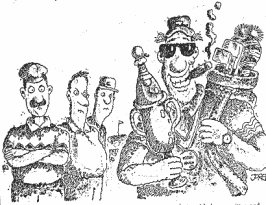
Golf’s Nefarious Villain!!!
That golfer that steadfastly clears all hurdles on their way to another Club Championship or any other tournament win … all the while claiming they’re just having a career round. The peculiar timing and consistency of these “career rounds” is the only evidence required to lift the veil of their dastardly plan and reveal their onion of layered lies.
Professional golfers play their score to par and compete against the course to determine who plays better and wins at any tournament because they are all considered to be of “Professional” quality play.
Amateur golfers, on the other hand, often play in Net Games where golfers are given strokes off their hole scores based on their Course Handicap. For example; a golfer with a 9 Course Handicap would be given one stroke (commonly referred to as a “pop”) on the 9 most difficult holes on the golf course based on each hole’s handicap rating. When used properly, amateur golfers can compete fairly against other golfers of even greatly varying abilities. The Index and Handicap System levels the playing field by affording the less skilled player more strokes against their more skilled opponents.
The true Sandbagger though, is the golfer who knows and understands how the handicapping system works and (not so cleverly) manipulates the algorithm and equations to their benefit. Thus, getting more strokes against their opponents while their potential to score better is still in their favor.
This article will introduce the hypothesis of the “Accidental Sandbagger” as the golfer who honestly doesn’t know they’re cheating because they don’t know how the system works and truly believe that their average score is what should be considered when competing against other golfers.
After an explanation of how the Index & Handicap System works, we’ll discuss the possibility of the “Accidental Sandbagger”.
For those uninitiated in the math and the science that determine a golfer’s Index and Course Handicap, the long and short of it is that the handicapping system does not care what you shoot for an average score. It cares only about a golfer’s potential – what is that golfer capable of scoring when playing at their best … not their average!!
That is why the Golf Index is calculated using only a golfer’s lowest scores based on the number of rounds entered. This table illustrates how many scores are used based on the appropriate number of rounds entered into the system. For example: if only 3 to 5 rounds are entered, the system uses only the lowest score. When 9, 10, or 11 rounds are entered, then the 3 lowest scores are averaged. And when a golfer enters 20 or more rounds, the system does its best and most accurate work by using the average of only the lowest 8 scores.
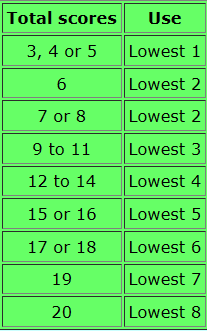
The true Sandbagger knows this and purposefully omits and never enters their low scores. Or, even more despicably, understands how the differential is calculated based on the course rating and adjust their scores entered into the system to dial in the number they want to be posted as their “Official” Golf Index!!
A golf course Rating is the number a Zero Index or Scratch Golfer would shoot when playing to their Index on any given course. So as an example, even if the par for the course is 72, a rating of 69.7 indicates that a Scratch Golfer playing to their Index would score 69.7 (rounded to 70 – or 2 strokes better than the course’s par score). The golf course Slope is the number used to show a golf course’s difficulty with 113 being the average number for a course slope.
The Index and Handicap system uses the Course Rating and Slope numbers from each golf course tee box to calculate any golfer’s Index and then their appropriate Course Handicap as follows:
There are three equations used in the Index & Handicap system:
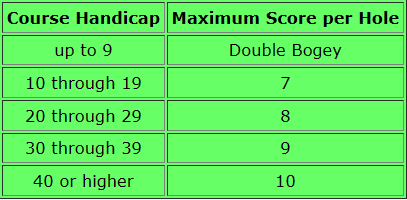
- The first is used to determine a golfer’s Score Differential for any round played based on the rules of ESC (Equitable Stroke Control), or the maximum score any golfer is allowed to post on any given hole;
Score Differential = (Adjusted Score - course rating) × 113/course slope – an example of this formula follows and would be adjusted for whichever tees were played and their corresponding Rating & Slope:
Gross Adjusted Score: 88
Course rating: 72.1
Course slope: 128
Following the formula above - (88 - 72.1) x 113/128
The Handicap Differential is 14
2. The second calculation then averages the lowest used Score Differentials to determine the Golf Index, (the number you’d find if you looked up a golfer’s GHIN # on the Golf Handicap Information Network);
3. The third equation then uses that Golf Index to determine the Golfer’s Handicap for any course played based on that course’s slope.
Course Handicap = Golf index x Course Slope /113 – an example of this formula follows and would be adjusted for whichever tees were played and their corresponding Rating & Slope:
Golfers Handicap
Index: 9
Gross score: 88
Course rating: 72.1
Course slope: 128
Following the formula above – 9 x 128/113 = 10
The net score would be 88 − 10 = 78.
Notice in the example above that the golfer’s Course Handicap of 10 is higher than their Index of 9. The calculations above use the Course Rating and Slope to determine the Golfer’s Index and Course Handicaps based on the established difficulty of the course playability. Once a golfer’s Index is determined based on the Rating and Slope of the courses they have played, their Handicap will be adjusted up or down based on the established difficulty of the course they are about to play using the Course Slope.
The True Golf Sandbagger knows these equations and understands how to manipulate the result by only entering the scores they know will deliver a higher posted Golf Index, so they can then receive more strokes off their score when competing in the Net Games so popular among amateur golfers.
But what about the golfer ignorant of the algorithm and equations used to accurately calculate a golfer’s Index and Handicap? They honestly believe in their heart that they are competing fairly against their competition because they think their average score is being measured against every other golfer’s average score. When in reality, they are unwittingly pitting their average score against other “honest” golfer’s best potential – an unfair match-up!!
So now let’s see if the numbers support the theory of the “Accidental Sandbagger”.
In a nutshell, the “Accidental Sandbagger” is using the average of ALL their scores to determine their Handicap, while the “Honest” golfer is accurately using the average of ONLY their best scores to determine theirs!!
The “Accidental Sandbagger” does not carry a certified Golf Index as determined by an official governing body such as the GHIN (Golf Handicap Information Network) system. Thus, the “Accidental Sandbagger” can’t show up at sanctioned tournaments because they most often require a verifiable Golf Index to permit entry into the field. So, the “Accidental Sandbagger” is the golfer who plays in weekly games and smaller organized events that some hosts post online to gather golfers together. Many times, in these events the host is equally ignorant of the intricacies of how the Golf Index & Handicap System functions to properly level the playing field so they simply ask the participant for their average score. This allows the players without an accurate and official Golf Index to then compete against the golfers who provided the tournament host with an accurate and verifiable Golf Index.
In this situation, the “Accidental Sandbagger” often works in unplanned cooperation with an equally uninformed tournament host, as the golfer enters the field of players and tells the host, “I don’t have a handicap, but I usually shoot in the mid to high eighties”. So, the tournament host enters the golfer at a handicap of 16 (88-72). Well, the actual Golf Index of a player that “averages” mid to high eighties may more accurately be closer to a 9 Index as that golfer will have wide breadth in their playing scores ranging from as high as sometimes into the 90s to also occasionally dropping scores near, at, or even just below 80.
Now, let’s see how the math factors into our “average score” golfer with a handicap of 16 compared to that of the “lowest average score” golfer with a handicap of 9 when scoring a 78 on a course with a Rating of 69.2 and a Slope of 117.
Golfers Handicap Index: 16
Gross score: 78
Course rating: 69.2
Course slope: 117
Following the formula of
Course Handicap = Golf index x Course Slope /113
16 x 117/113 = 16.566 (rounded to 17), and the net score would be 78 − 17 = 61.
That’s a Differential of minus 8.2 (the score of 61 minus the 69.2-course rating)
Golfers Handicap Index: 9
Gross score: 78
Course rating: 69.2
Course slope: 117
Following the formula Course
Handicap = Golf index x Course Slope /113
9 x 117/113 = 9.318 (rounded to 9), and the net score would be 78 − 9 = 69.
That’s a differential of minus 0.2 (the score of 69 minus the 69.2-course rating)
Now, let’s apply the odds table of any golfer scoring to their Golf Handicap or better for any given round. The odds of a 16-index scoring 8.2 shots differential better than their handicap are a whopping 1 in 1138 rounds. While that same golfer playing to their true index of 9 shooting the same score of 78 produces a differential of just 0.2 strokes better than their index or a much more plausible 1 in 5 rounds occurrence.
Proving that the uneducated golfer who believes their index is determined by their average score can Sandbag the field by scoring to their true index, claim their false handicap strokes, and destroy the field by scoring a net 61 for a once-in-1138-round performance when they only just scored to their index in a once every five rounds occurrence.
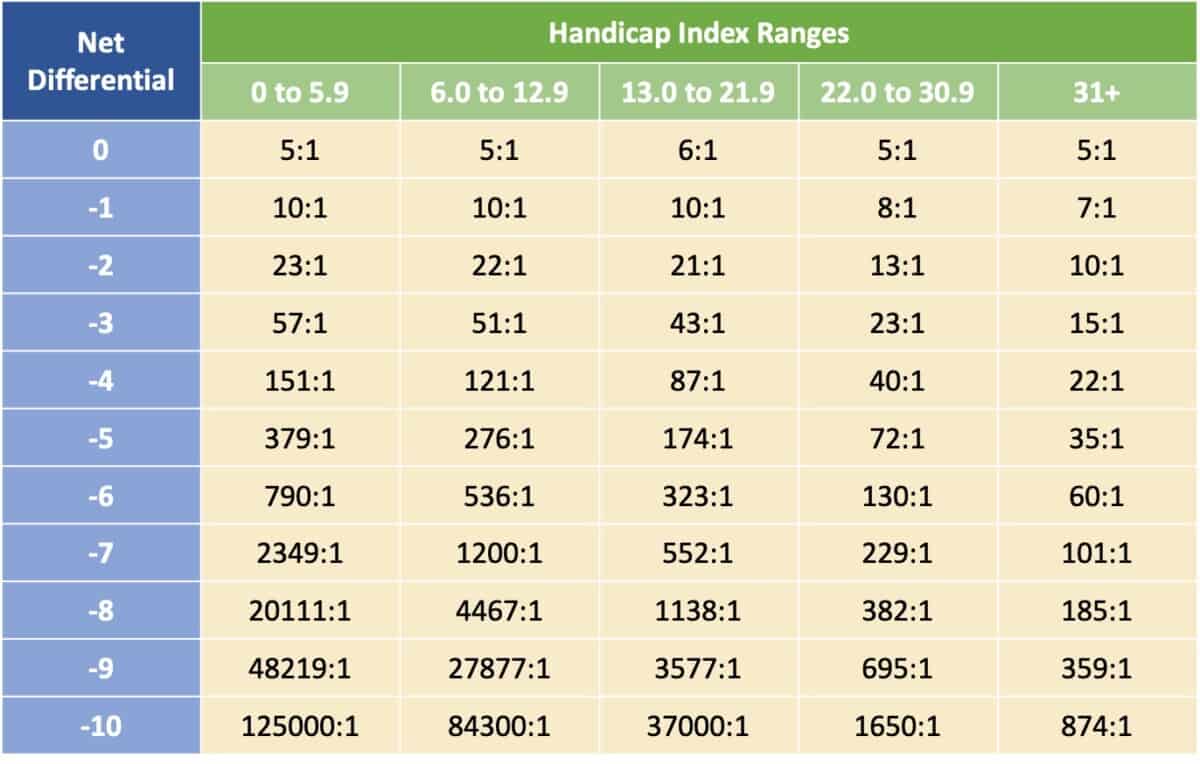
The above example was taken from a golfer who shot that 78 in a 2-Man Shamble Golf Tournament where two golfers both hit a tee shot and then each play their own ball into the hole from what they choose to be the better drive based on distance and/or position to hit their next shot. Scores will be better in that scenario, but truly, that only makes it easier for a golfer to score to or maybe slightly better than their Index, yet not shatter it by 8.2 shots.
Here’s another example taken from a local skins game that also has a payout for the low net score where a 9 Index shot a gross 69 with no mulligans and no breakfast balls. His 69 gave him a net 60 on a course with a rating of 69.7 for a differential of an astronomical minus 9.7. That number comes in at an unbelievable 1 in about 67,373 rounds. A golfer would have to play one round every day of the year for 185+ years to tally that many rounds! Seriously?? A 9 Index scoring a gross 69 is NOT improbable! It’s Impossible!!!! To put this another way – if a 9 Index could do that, there would have been other rounds in the very low 70s that would have reduced their Index to a number making the 69 far more reasonable to understand and accept.
Getting back to our example though - assuming that a golfer who claims to be a 9 shoots an average score of about 80 and drops the occasional 73 and 74. That would probably make him closer to a 4 index. So, let’s run the numbers:
Golfers Handicap Index: 9
Gross score: 69
Course rating: 69.7
Course slope: 113
Following the formula Course
Handicap = Golf index x Course Slope /113
9 x 113/113 = 9 and the net score would be 69 − 9 = 60.
That’s a differential of minus 9.7 (the score of 60 minus the 69.7-course rating)
Golfers Handicap Index: 4
Gross score: 69
Course rating: 69.7
Course slope: 113
Following the formula Course
Handicap = Golf index x Course Slope /113
4 x 113/113 = 4 and the net score would be 69 − 4 = 65.
That’s a differential of minus 4.7 (the score of 65 minus the 69.7-course rating)
Even at the adjusted Index of 4, this score is a once in more than a 200-round occurrence seriously bringing into question the character of a golfer that shamelessly strolls out to the course, accepts 9 strokes (or even 4), shoots a gross 69 and with a straight face, claims his winnings!
I could find no official Index in the GHIN System for either of the golfers highlighted above. This first led me to believe that they may be uneducated on how the system works and quote their average scores to the tournament director upon entry. I also personally know both the tournament directors and have seen how they run their events and I believe neither of them truly understand the Golf Index & Handicap System. The combination of these two observations, plus the guy in the first example bragging online about his score, oblivious to the statistical improbability of his accomplishment brought me to the hypothesis of the “Accidental Sandbagger”.
The “True Golf Sandbagger” approaches the game with purpose and truly evil intentions to cheat and deceive their competition and needs to be figuratively brought out to a tall tree with a short piece of rope and hung. While the “Accidental Sandbagger”, on the other hand, is simply oblivious to their unintended deceit and does just need education and some direction on how to fairly compete in the world of amateur golf.
The moral of the story guys is simple. Get yourself an official Golf Index through the GHIN (Golf Handicap Information Network), or the USGA, and then just enter the scores you shoot – the system will do all the heavy lifting to generate your true, honest, and accurate Golf Index. Thereby allowing you to honestly and fairly compete in any tournament, weekly game, or organized event. You’ll win occasionally and so will everyone else!
Keeping in mind that on average, a golfer will shoot to their Index once every five rounds. That translates to the fact that 80% of the time we amateurs tee it up we’re not going to be happy with our round. 80% - that’s enough for many of us to question whether or not we’re still outdoor athletes, or whether, maybe, we should invest in a nice chess board or get the number of that bowling league. Only 20% of the time will we amateurs walk off the golf course happy with how our balance, tempo, and timing came together to produce a round where we felt as though we played our best. Understanding that simple truth will free you to accept that some days are going to be better than others … and those days only statistically occur 20% of the times we play.
So, now there are two philosophies by which you can play golf:
1. Hit ‘em straight and not too often!! - or,
2. Since you pay good money to play a round of golf - hit the ball as many times as you can and see as much of the course as possible – value for your dollar!!
It’s a maddening and very addictive game!!
Enjoy your good walk interrupted!!
Return to the Top of this Page
?? Your Own Website ??
Is there a topic or a hobby for which you have a strong passion?
Have you ever considered turning that passion into a passive income stream?
Have you ever considered creating a web site like this one?
I researched long and hard for the best resources available on the web to assist me in making The-Golf-Experience.com a reality and I found none better than Solo Build It with whom to partner.
Above and beyond the comprehensive program they provide to assist you on your journey is the incredible level of customer service you'll get along the way. The world would be a better place if every company out there modeled the quality and level of their customer service after what Solo Build It seems to provide with such ease.
Watch the video below to see if your interest in creating your own web site gets a spark.
You ready?
Now click the "Solo Build It!" link below to begin your own journey.
Good luck and have some fun.
© Copyright The-Golf-Experience.com
"When Health is absent, wisdom cannot reveal itself, art cannot become manifest, strength cannot be exerted, wealth is useless, and reason is powerless."
Herophilos 335-280 B.C.
All athletes require the performance components of: strength, power, endurance, flexibility, coordination, balance, good posture, and mental conditioning to perform at their best.
Stay Healthy - Play your Best
~ ~ ~
Visit our Fitness Page to learn more!
Start investing with Acorns today and they'll add $5 to to your account to help you get started - You won't retire on their contribution ... but $5 is still $5
Visit our page on Golf Balls to learn ALL you need to know to determine which ball is best suited to your unique swing speed and style of play.
Then visit Lost Golf Balls below to buy used golf balls in the quality suited to your game and the quantity required to keep your bag full.
Find Inexpensive Gas with Gas Buddy
If you really want to save at the pump though - Get yourself a Pay With Gas Buddy Card.
Join for free to save $.05 per gallon or get a Plus or Premuim Membership to save $.20 per gallon.
Points are awarded for each score on every hole. You can use any modification for points awarded (or subtracted) on every hole, but the R&A and the USGA award points as follows:
If you appreciate exceptional customer service and personal attention given to filling your golf needs The-Golf-Experience.com highly recommends shopping with





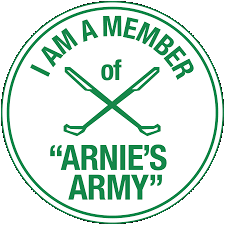



















New! Comments
Join the conversation by sharing your comments and opinions about the content on this topic in the box below.